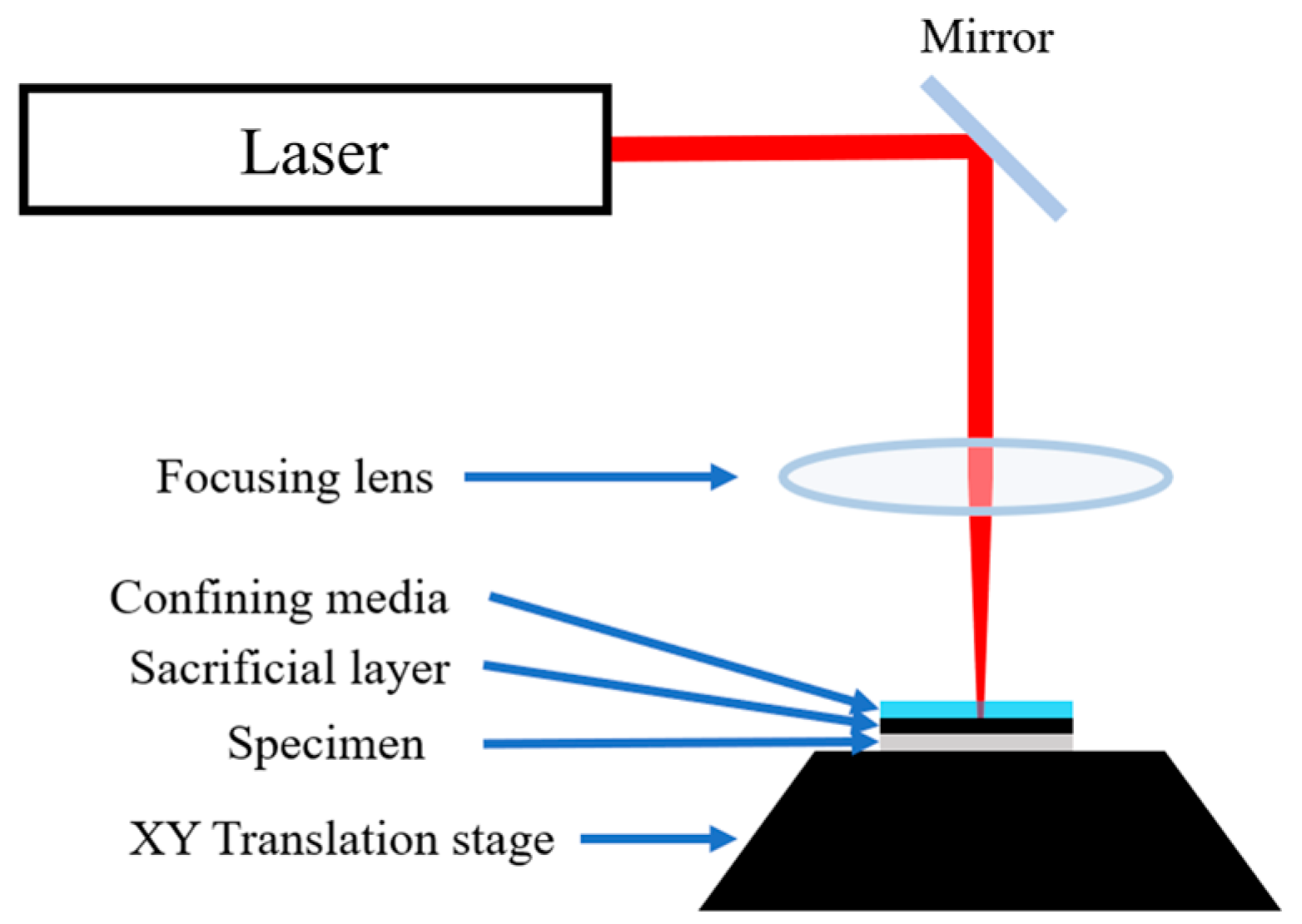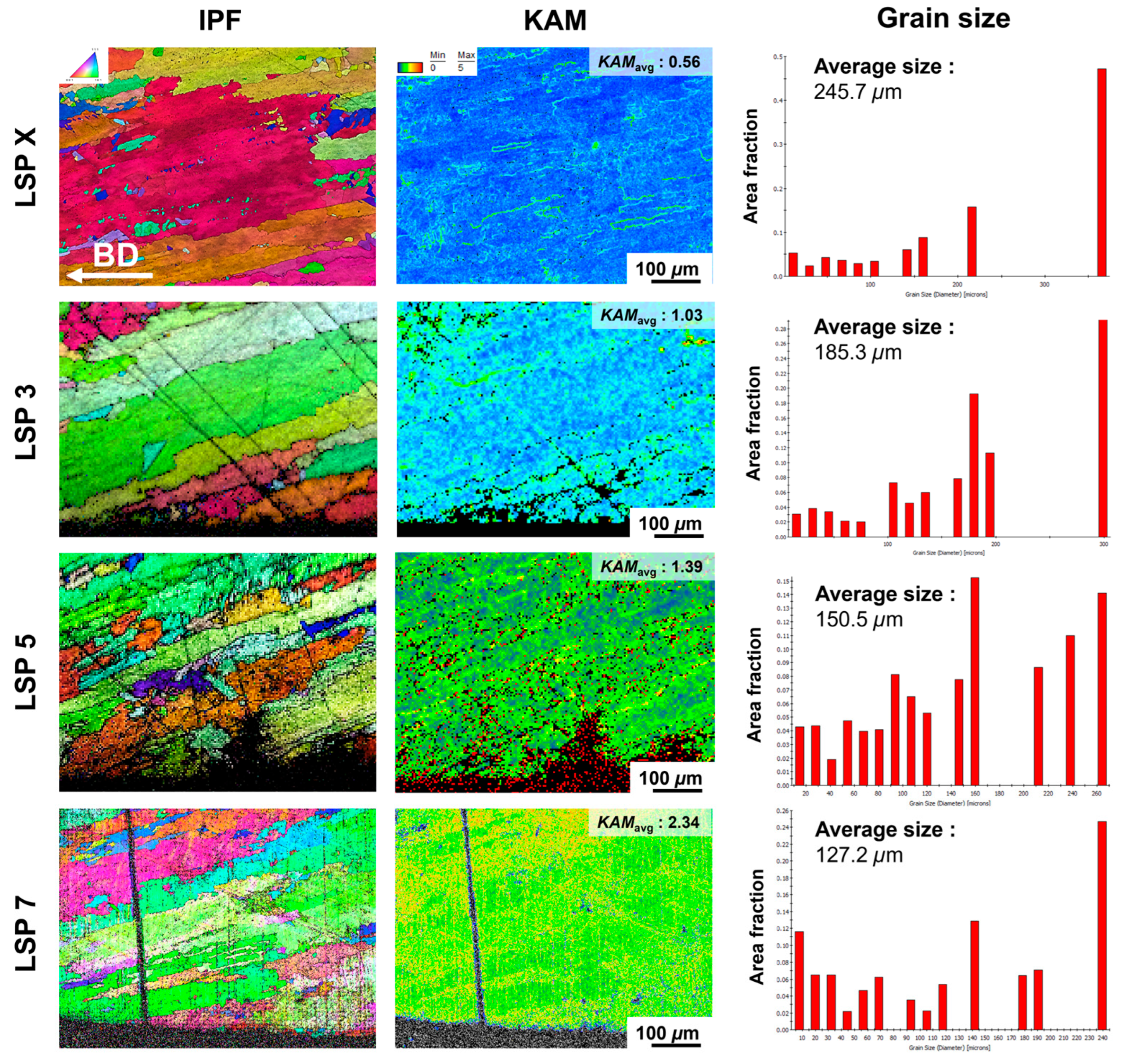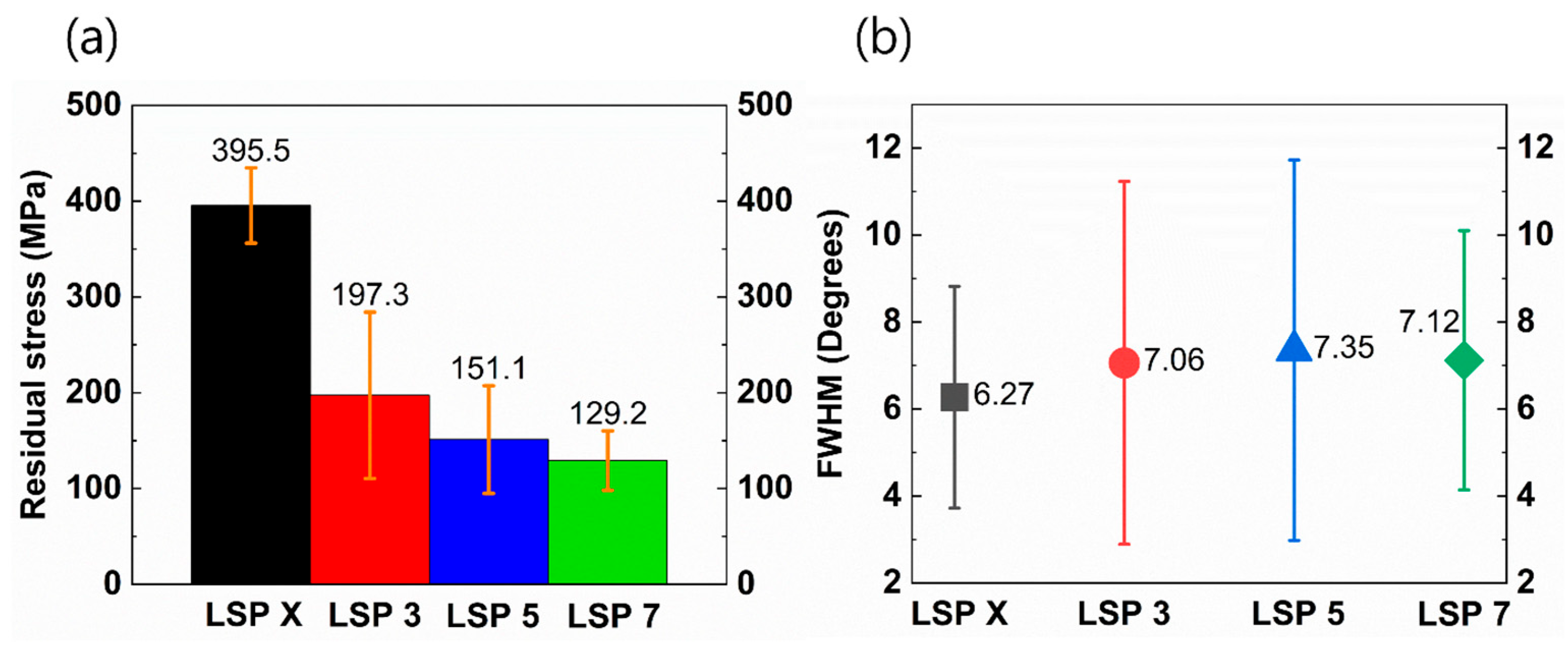Enhancement of Mechanical Properties and Hydrogen Embrittlement Resistance of Laser-Directed Energy Deposition-Fabricated 316L Stainless Steel by Laser Shock Peening
Abstract
1. Introduction
2. Materials and Methods
3. Results and Discussion
4. Conclusions
Funding
Institutional Review Board Statement
Informed Consent Statement
Data Availability Statement
Conflicts of Interest
References
- Niaz, S.; Manzoor, T.; Pandith, A.H. Hydrogen storage: Materials, methods and perspectives. Renew. Sustain. Energy Rev. 2015, 50, 457–469. [Google Scholar] [CrossRef]
- Kim, S.-G.; Kim, J.-Y.; Seo, H.-J.; Jung, H.-G.; Park, J.; Baek, U.-B.; Hwang, B. Hydrogen embrittlement characteristics of tempered martensitic steels under electrochemical and high-pressure hydrogen environments. Korean J. Met. Mater. 2023, 61, 807–814. [Google Scholar] [CrossRef]
- Ko, S.-W.; Lee, J.-M.; Hwang, B. Effect of nb addition and pre-strain on hydrogen embrittlement of low-carbon steels with ferrite-pearlite structure. Korean J. Met. Mater. 2020, 58, 752–758. [Google Scholar] [CrossRef]
- Srinivasan, S.; Demirocak, D.E.; Kaushik, A.; Sharma, M.; Chaudhary, G.R.; Hickman, N.; Stefanakos, E. Reversible hydrogen storage using nanocomposites. Appl. Sci. 2020, 10, 4618. [Google Scholar] [CrossRef]
- Abreu Araujo, L.; Rebolledo Ramos, N.; Torres Martín, J.E.; Chinchón-Payá, S.; Sánchez Montero, J.; Lample Carreras, R.M.; Vera-Agullo, J.; Jimenez-Vicaria, J.D. Concrete gas permeability: Implications for hydrogen storage applications. Appl. Sci. 2024, 14, 6408. [Google Scholar] [CrossRef]
- Reda, R.; Ataya, S.; Ayman, M.; Saad, K.; Mostafa, S.; Elnady, G.; Khan, R.; Elshaghoul, Y.G. Additively manufactured 316L stainless steel: Hydrogen embrittlement susceptibility and electrochemical gas production. Appl. Sci. 2025, 15, 5824. [Google Scholar] [CrossRef]
- Oriani, R. Hydrogen embrittlement of steels. Annu. Rev. Mater. Sci. 1978, 8, 327–357. [Google Scholar] [CrossRef]
- Robertson, I.M.; Sofronis, P.; Nagao, A.; Martin, M.L.; Wang, S.; Gross, D.; Nygren, K. Hydrogen embrittlement understood. Metall. Mater. Trans. A 2015, 46, 2323–2341. [Google Scholar] [CrossRef]
- Bertsch, K.; Nagao, A.; Rankouhi, B.; Kuehl, B.; Thoma, D. Hydrogen embrittlement of additively manufactured austenitic stainless steel 316 L. Corros. Sci. 2021, 192, 109790. [Google Scholar]
- Lynch, S. Mechanistic and fractographic aspects of stress corrosion cracking. Corros. Rev. 2012, 30, 63–104. [Google Scholar] [CrossRef]
- Martin, M.L.; Fenske, J.A.; Liu, G.S.; Sofronis, P.; Robertson, I.M. On the formation and nature of quasi-cleavage fracture surfaces in hydrogen embrittled steels. Acta Mater. 2011, 59, 1601–1606. [Google Scholar] [CrossRef]
- Murakami, Y.; Kanezaki, T.; Mine, Y. Hydrogen effect against hydrogen embrittlement. Metall. Mater. Trans. A 2010, 41, 2548–2562. [Google Scholar] [CrossRef]
- Dwivedi, S.K.; Vishwakarma, M. Hydrogen embrittlement in different materials: A review. Int. J. Hydrogen Energy 2018, 43, 21603–21616. [Google Scholar] [CrossRef]
- Claeys, L.; Deconinck, L.; Verbeken, K.; Depover, T. Effect of additive manufacturing and subsequent heat and/or surface treatment on the hydrogen embrittlement sensitivity of 316L austenitic stainless steel. Int. J. Hydrogen Energy 2023, 48, 36142–36157. [Google Scholar] [CrossRef]
- Hong, Y.; Zhou, C.; Zheng, Y.; Zhang, L.; Zheng, J.; Chen, X.; An, B. Formation of strain-induced martensite in selective laser melting austenitic stainless steel. Mater. Sci. Eng. A 2019, 740, 420–426. [Google Scholar] [CrossRef]
- Chen, J.; Wei, H.; Bao, K.; Zhang, X.; Cao, Y.; Peng, Y.; Kong, J.; Wang, K. Dynamic mechanical properties of 316L stainless steel fabricated by an additive manufacturing process. J. Mater. Res. Technol. 2021, 11, 170–179. [Google Scholar] [CrossRef]
- Bartolomeu, F.; Buciumeanu, M.; Pinto, E.; Alves, N.; Carvalho, O.; Silva, F.; Miranda, G. 316L stainless steel mechanical and tribological behavior—A comparison between selective laser melting, hot pressing and conventional casting. Addit. Manuf. 2017, 16, 81–89. [Google Scholar] [CrossRef]
- Tan, C.; Chew, Y.; Duan, R.; Weng, F.; Sui, S.; Ng, F.L.; Du, Z.; Bi, G. Additive manufacturing of multi-scale heterostructured high-strength steels. Mater. Res. Lett. 2021, 9, 291–299. [Google Scholar] [CrossRef]
- Singh, S.N.; Deoghare, A.B. Laser shock peening of laser based directed energy deposition and powder bed fusion additively manufactured parts: A review. Met. Mater. Int. 2023, 29, 1563–1585. [Google Scholar] [CrossRef]
- Kang, N.; Lin, X.; El Mansori, M.; Wang, Q.; Lu, J.; Coddet, C.; Huang, W. On the effect of the thermal cycle during the directed energy deposition application to the in-situ production of a ti-mo alloy functionally graded structure. Addit. Manuf. 2020, 31, 100911. [Google Scholar] [CrossRef]
- Huang, S.; Ma, D.; Sheng, J.; Agyenim-Boateng, E.; Zhao, J.; Zhou, J. Effects of laser peening on tensile properties and martensitic transformation of aisi 316L stainless steel in a hydrogen-rich environment. Mater. Sci. Eng. A 2020, 788, 139543. [Google Scholar] [CrossRef]
- Leuders, S.; Meiners, S.; Wu, L.; Taube, A.; Tröster, T.; Niendorf, T. Structural components manufactured by selective laser melting and investment casting—Impact of the process route on the damage mechanism under cyclic loading. J. Mater. Process. Technol. 2017, 248, 130–142. [Google Scholar] [CrossRef]
- AlMangour, B.; Yang, J.-M. Improving the surface quality and mechanical properties by shot-peening of 17-4 stainless steel fabricated by additive manufacturing. Mater. Des. 2016, 110, 914–924. [Google Scholar] [CrossRef]
- Ouyang, P.; Dong, Z.; Luo, X.; Zhang, S.; Liu, L.; Sun, B.; Zhou, L. Effect of combined treatment of laser shock peening and shot peening on fatigue performance of laser-powder-bed-fusioned gh4169 nickel-based alloy. Opt. Laser Technol. 2025, 182, 112141. [Google Scholar] [CrossRef]
- Zha, X.; Xi, L.; Guo, Y.; Chen, X.; Chen, X.; Guo, B.; Li, Y.; Xu, Z.; Jiang, F. Investigation on mechanical properties and surface strengthening mechanism of the cemented carbide processed by laser shock peening. J. Mater. Res. Technol. 2025, 35, 2119–2135. [Google Scholar] [CrossRef]
- Li, X.-f.; Zhang, J.; Ma, M.-m.; Song, X.-l. Effect of shot peening on hydrogen embrittlement of high strength steel. Int. J. Miner. Metall. Mater. 2016, 23, 667–675. [Google Scholar] [CrossRef]
- Hui, W.; Zhang, Y.; Zhao, X.; Shao, C.; Wang, K.; Sun, W.; Yu, T. Influence of cold deformation and annealing on hydrogen embrittlement of cold hardening bainitic steel for high strength bolts. Mater. Sci. Eng. A 2016, 662, 528–536. [Google Scholar] [CrossRef]
- Chen, C.; Xie, Y.; Yan, X.; Yin, S.; Fukanuma, H.; Huang, R.; Zhao, R.; Wang, J.; Ren, Z.; Liu, M. Effect of hot isostatic pressing (hip) on microstructure and mechanical properties of ti6al4v alloy fabricated by cold spray additive manufacturing. Addit. Manuf. 2019, 27, 595–605. [Google Scholar] [CrossRef]
- Álvarez, G.; Harris, Z.; Wada, K.; Rodríguez, C.; Martínez-Pañeda, E. Hydrogen embrittlement susceptibility of additively manufactured 316L stainless steel: Influence of post-processing, printing direction, temperature and pre-straining. Addit. Manuf. 2023, 78, 103834. [Google Scholar] [CrossRef]
- Wang, Y.; Wu, X.; Zhou, Z.; Li, X. Numerical analysis of hydrogen transport into a steel after shot peening. Results Phys. 2018, 11, 5–16. [Google Scholar] [CrossRef]
- Takeda, S.; Ohara, Y.; Uchimoto, T.; Enoki, H.; Iijima, T.; Tokuda, E.; Yamada, T.; Nagatomo, Y. Characterization of fatigue crack of hydrogen-charged austenitic stainless steel by electromagnetic and ultrasonic techniques. Int. J. Hydrogen Energy 2022, 47, 32223–32234. [Google Scholar] [CrossRef]
- Peyre, P.; Scherpereel, X.; Berthe, L.; Carboni, C.; Fabbro, R.; Béranger, G.; Lemaitre, C. Surface modifications induced in 316L steel by laser peening and shot-peening. Influence on pitting corrosion resistance. Mater. Sci. Eng. A 2000, 280, 294–302. [Google Scholar] [CrossRef]
- Shin, D.-H.; Kim, S.-J. Effect of hydrogen embrittlement on mechanical characteristics of dlc-coating for hydrogen valves of fcevs. npj Mater. Degrad. 2024, 8, 47. [Google Scholar] [CrossRef]
- Agyenim-Boateng, E.; Huang, S.; Sheng, J.; Yuan, G.; Wang, Z.; Zhou, J.; Feng, A. Influence of laser peening on the hydrogen embrittlement resistance of 316L stainless steel. Surf. Coat. Technol. 2017, 328, 44–53. [Google Scholar] [CrossRef]
- Sun, R.; Li, L.; Zhu, Y.; Zhang, L.; Guo, W.; Peng, P.; Li, B.; Guo, C.; Liu, L.; Che, Z. Dynamic response and residual stress fields of ti6al4v alloy under shock wave induced by laser shock peening. Modell. Simul. Mater. Sci. Eng. 2017, 25, 065016. [Google Scholar] [CrossRef]
- Peyre, P.; Fabbro, R.; Merrien, P.; Lieurade, H. Laser shock processing of aluminium alloys. Application to high cycle fatigue behaviour. Mater. Sci. Eng. A 1996, 210, 102–113. [Google Scholar] [CrossRef]
- Pan, X.; Zhou, L.; Wang, C.; Yu, K.; Zhu, Y.; Yi, M.; Wang, L.; Wen, S.; He, W.; Liang, X. Microstructure and residual stress modulation of 7075 aluminum alloy for improving fatigue performance by laser shock peening. Int. J. Mach. Tools Manuf. 2023, 184, 103979. [Google Scholar] [CrossRef]
- Fabbro, R.; Fournier, J.; Ballard, P.; Devaux, D.; Virmont, J. Physical study of laser-produced plasma in confined geometry. J. Appl. Phys. 1990, 68, 775–784. [Google Scholar] [CrossRef]
- Xu, G.; Luo, K.; Dai, F.; Lu, J. Effects of scanning path and overlapping rate on residual stress of 316L stainless steel blade subjected to massive laser shock peening treatment with square spots. Appl. Surf. Sci. 2019, 481, 1053–1063. [Google Scholar] [CrossRef]
- Peyre, P.; Berthe, L.; Scherpereel, X.; Fabbro, R. Laser-shock processing of aluminium-coated 55c1 steel in water-confinement regime, characterization and application to high-cycle fatigue behaviour. J. Mater. Sci. 1998, 33, 1421–1429. [Google Scholar] [CrossRef]
- Berthe, L.; Fabbro, R.; Peyre, P.; Tollier, L.; Bartnicki, E. Shock waves from a water-confined laser-generated plasma. J. Appl. Phys. 1997, 82, 2826–2832. [Google Scholar] [CrossRef]
- Li, Y.; Li, Y.; Wang, X.; Xu, W.; Qiao, F.; Wang, S. Effect of nanosecond pulse laser shock peening on the microstructure and performance of welded joint of 316L stainless steel. In Proceedings of the Chinese Materials Conference, Yinchuan, China, 6–12 July 2017; pp. 113–125. [Google Scholar]
- Glaser, D.; Polese, C.; Venter, A.; Marais, D.; Plaisier, J. Evaluation of laser shock peening process parameters incorporating almen strip deflections. Surf. Coat. Technol. 2022, 434, 128158. [Google Scholar] [CrossRef]
- Zheng, B.; Haley, J.; Yang, N.; Yee, J.; Terrassa, K.; Zhou, Y.; Lavernia, E.; Schoenung, J. On the evolution of microstructure and defect control in 316L ss components fabricated via directed energy deposition. Mater. Sci. Eng. A 2019, 764, 138243. [Google Scholar] [CrossRef]
- Gaudin, C.; Feaugas, X. Cyclic creep process in aisi 316L stainless steel in terms of dislocation patterns and internal stresses. Acta Mater. 2004, 52, 3097–3110. [Google Scholar] [CrossRef]
- Feaugas, X. On the origin of the tensile flow stress in the stainless steel aisi 316L at 300 k: Back stress and effective stress. Acta Mater. 1999, 47, 3617–3632. [Google Scholar] [CrossRef]
- Mirzadeh, H.; Najafizadeh, A. Correlation between processing parameters and strain-induced martensitic transformation in cold worked aisi 301 stainless steel. Mater. Charact. 2008, 59, 1650–1654. [Google Scholar] [CrossRef]
- San Marchi, C.; Somerday, B.; Tang, X.; Schiroky, G. Effects of alloy composition and strain hardening on tensile fracture of hydrogen-precharged type 316 stainless steels. Int. J. Hydrogen Energy 2008, 33, 889–904. [Google Scholar] [CrossRef]
- Li, L.; Zhang, X.; Cui, W.; Liou, F.; Deng, W.; Li, W. Temperature and residual stress distribution of fgm parts by ded process: Modeling and experimental validation. Int. J. Adv. Manuf. Technol. 2020, 109, 451–462. [Google Scholar] [CrossRef]
- Smudde, C.M.; San Marchi, C.W.; Hill, M.R.; Gibeling, J.C. Effects of residual stress on orientation dependent fatigue crack growth rates in additively manufactured stainless steel. Int. J. Fatigue 2023, 169, 107489. [Google Scholar] [CrossRef]
- Vashista, M.; Paul, S. Correlation between full width at half maximum (fwhm) of xrd peak with residual stress on ground surfaces. Philos. Mag. 2012, 92, 4194–4204. [Google Scholar] [CrossRef]
- Wu, J.; Liu, H.; Wei, P.; Zhu, C.; Lin, Q. Effect of shot peening coverage on hardness, residual stress and surface morphology of carburized rollers. Surf. Coat. Technol. 2020, 384, 125273. [Google Scholar] [CrossRef]
- Zhu, L.; Guan, Y.; Wang, Y.; Xie, Z.; Lin, J. Influence of process parameters of ultrasonic shot peening on surface nanocrystallization and hardness of pure titanium. Int. J. Adv. Manuf. Technol. 2017, 89, 1451–1468. [Google Scholar] [CrossRef]
- Child, D.; West, G.; Thomson, R. Assessment of surface hardening effects from shot peening on a ni-based alloy using electron backscatter diffraction techniques. Acta Mater. 2011, 59, 4825–4834. [Google Scholar] [CrossRef]
- Lin, Q.; Liu, H.; Zhu, C.; Parker, R.G. Investigation on the effect of shot peening coverage on the surface integrity. Appl. Surf. Sci. 2019, 489, 66–72. [Google Scholar] [CrossRef]
- Eskandari, M.; Najafizadeh, A.; Kermanpur, A. Effect of strain-induced martensite on the formation of nanocrystalline 316L stainless steel after cold rolling and annealing. Mater. Sci. Eng. A 2009, 519, 46–50. [Google Scholar] [CrossRef]
- Alam, M.T.; Ahmad, T.; Alshoaibi, A.M.; Aziz, A.; Husain, D.; Ahmad, S. Comprehensive study on the properties of az91/x-si3n4 composites for their prospective application. Appl. Sci. 2024, 14, 4444. [Google Scholar] [CrossRef]
- Astafurova, E.; Maier, G.; Melnikov, E.; Moskvina, V.; Vojtsik, V.; Zakharov, G.; Smirnov, A.; Bataev, V. Effect of hydrogen charging on mechanical twinning, strain hardening, and fracture of ‹111› and ‹144› hadfield steel single crystals. Phys. Mesomech. 2018, 21, 263–273. [Google Scholar] [CrossRef]
- Li, S.-H.; Lee, D.-H.; Zhao, Y.; Ramamurty, U. Hydrogen-induced softening and embrittlement in 316L stainless steel fabricated using laser-powder bed fusion. Acta Mater. 2024, 274, 119959. [Google Scholar] [CrossRef]
- Song, Y.; Huang, S.; Sheng, J.; Agyenim-Boateng, E.; Jiang, Y.; Liu, Q.; Zhu, M. Improvement of hydrogen embrittlement resistance of 2205 duplex stainless steel by laser peening. Int. J. Hydrogen Energy 2023, 48, 18930–18945. [Google Scholar] [CrossRef]
- Koyama, M.; Akiyama, E.; Tsuzaki, K.; Raabe, D. Hydrogen-assisted failure in a twinning-induced plasticity steel studied under in situ hydrogen charging by electron channeling contrast imaging. Acta Mater. 2013, 61, 4607–4618. [Google Scholar] [CrossRef]
- San Marchi, C.; Somerday, B.P.; Robinson, S.L. Permeability, solubility and diffusivity of hydrogen isotopes in stainless steels at high gas pressures. Int. J. Hydrogen Energy 2007, 32, 100–116. [Google Scholar] [CrossRef]
- Matsuo, T.; Yamabe, J.; Matsuoka, S. Effects of hydrogen on tensile properties and fracture surface morphologies of type 316L stainless steel. Int. J. Hydrogen Energy 2014, 39, 3542–3551. [Google Scholar] [CrossRef]














| Powder | Fe | C | Cr | Ni | Mo | Si | Al | Mn |
|---|---|---|---|---|---|---|---|---|
| SUS 316L | Bal. | 0.027 | 16.95 | 10.08 | 2.42 | 0.55 | 0.33 | 1.40 |
| Parameters | Value |
|---|---|
| Laser power (W) | 1600 |
| Scan speed (mm/min) | 1000 |
| Powder feed rate (g/min) | 12 |
| Laser thickness (mm) | 1 |
| Overlap (mm) | 1.5 |
| Spot size (mm) | 3 |
| Parameters | Value |
|---|---|
| Laser power density (GW/cm2) | 5.54 |
| Laser induced pressure (GPa) | 1.98 |
| Laser pulse energy (mJ) | 2000 |
| Pulse duration (ns) | 11.5 |
| Repetition rate (Hz) | 10 |
| Scan speed (mm/s) | 10 |
| Pulse overlap (mm) | 1 |
| Spot size (mm) | 2 |
| Without Hydrogen Pre-Charging | With Hydrogen Pre-Charging | |||||||
|---|---|---|---|---|---|---|---|---|
| Specimen | Yield Strength | Tensile Strength | Elongation | Specimen | Yield Strength | Tensile Strength | Elongation | HE Index |
| LSP X | 297.8 MPa | 542.1 MPa | 64.2% | LSP X_H | 292.2 MPa | 519.6 MPa | 41.0% | 36.1% |
| LSP 3 | 331.7 MPa | 543.4 MPa | 71.1% | LSP 3_H | 384.2 MPa | 560.6 MPa | 53.0% | 25.5% |
| LSP 5 | 415.4 MPa | 567.0 MPa | 60.4% | LSP 5_H | 427.0 MPa | 575.9 MPa | 50.0% | 17.2% |
| LSP 7 | 410.0 MPa | 576.5 MPa | 52.6% | LSP 7_H | 436.1 MPa | 579.4 MPa | 46.0% | 12.5% |
Disclaimer/Publisher’s Note: The statements, opinions and data contained in all publications are solely those of the individual author(s) and contributor(s) and not of MDPI and/or the editor(s). MDPI and/or the editor(s) disclaim responsibility for any injury to people or property resulting from any ideas, methods, instructions or products referred to in the content. |
© 2025 by the author. Licensee MDPI, Basel, Switzerland. This article is an open access article distributed under the terms and conditions of the Creative Commons Attribution (CC BY) license (https://creativecommons.org/licenses/by/4.0/).
Share and Cite
Ha, J. Enhancement of Mechanical Properties and Hydrogen Embrittlement Resistance of Laser-Directed Energy Deposition-Fabricated 316L Stainless Steel by Laser Shock Peening. Appl. Sci. 2025, 15, 9481. https://doi.org/10.3390/app15179481
Ha J. Enhancement of Mechanical Properties and Hydrogen Embrittlement Resistance of Laser-Directed Energy Deposition-Fabricated 316L Stainless Steel by Laser Shock Peening. Applied Sciences. 2025; 15(17):9481. https://doi.org/10.3390/app15179481
Chicago/Turabian StyleHa, Jeonghong. 2025. "Enhancement of Mechanical Properties and Hydrogen Embrittlement Resistance of Laser-Directed Energy Deposition-Fabricated 316L Stainless Steel by Laser Shock Peening" Applied Sciences 15, no. 17: 9481. https://doi.org/10.3390/app15179481
APA StyleHa, J. (2025). Enhancement of Mechanical Properties and Hydrogen Embrittlement Resistance of Laser-Directed Energy Deposition-Fabricated 316L Stainless Steel by Laser Shock Peening. Applied Sciences, 15(17), 9481. https://doi.org/10.3390/app15179481







